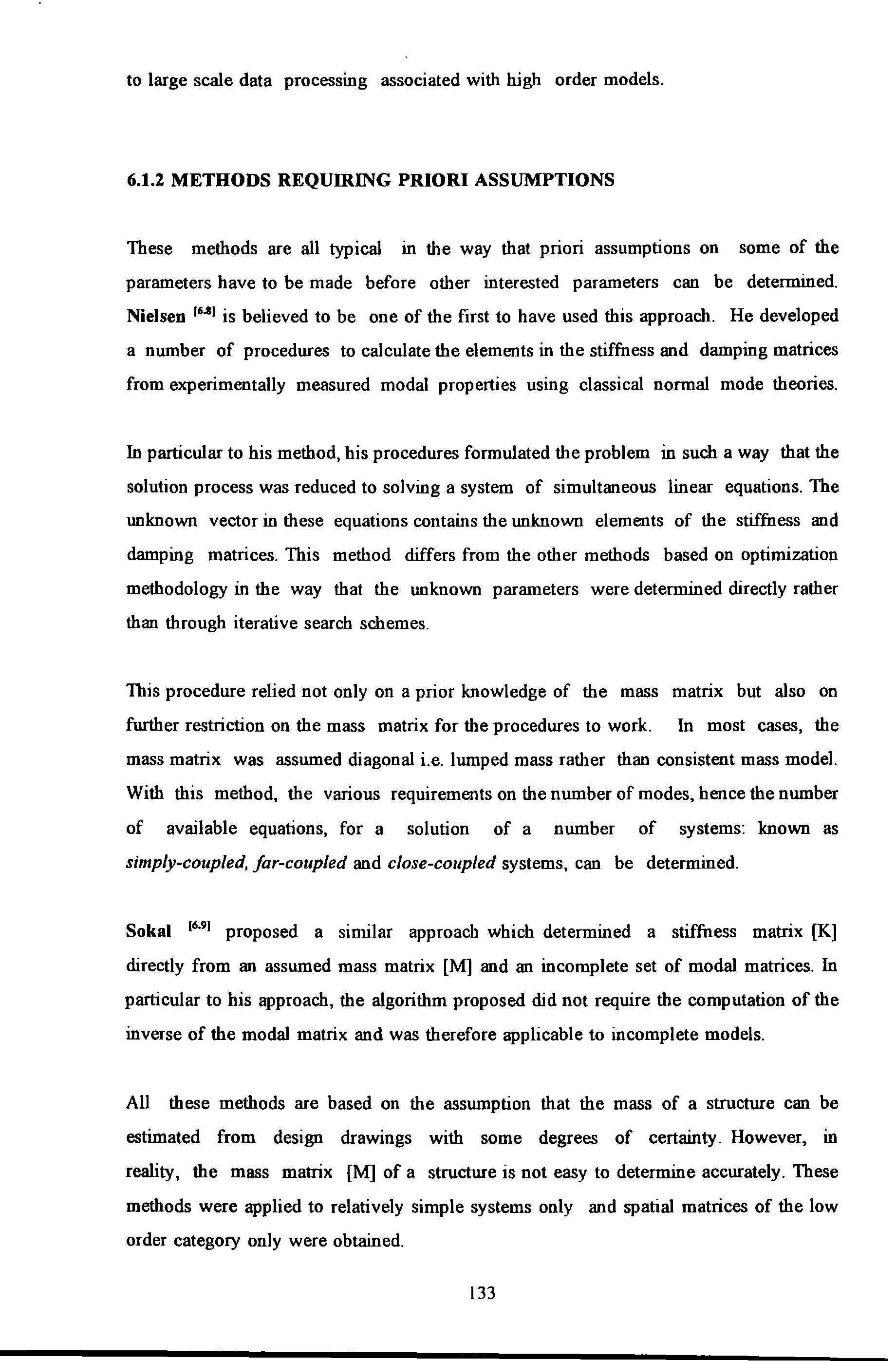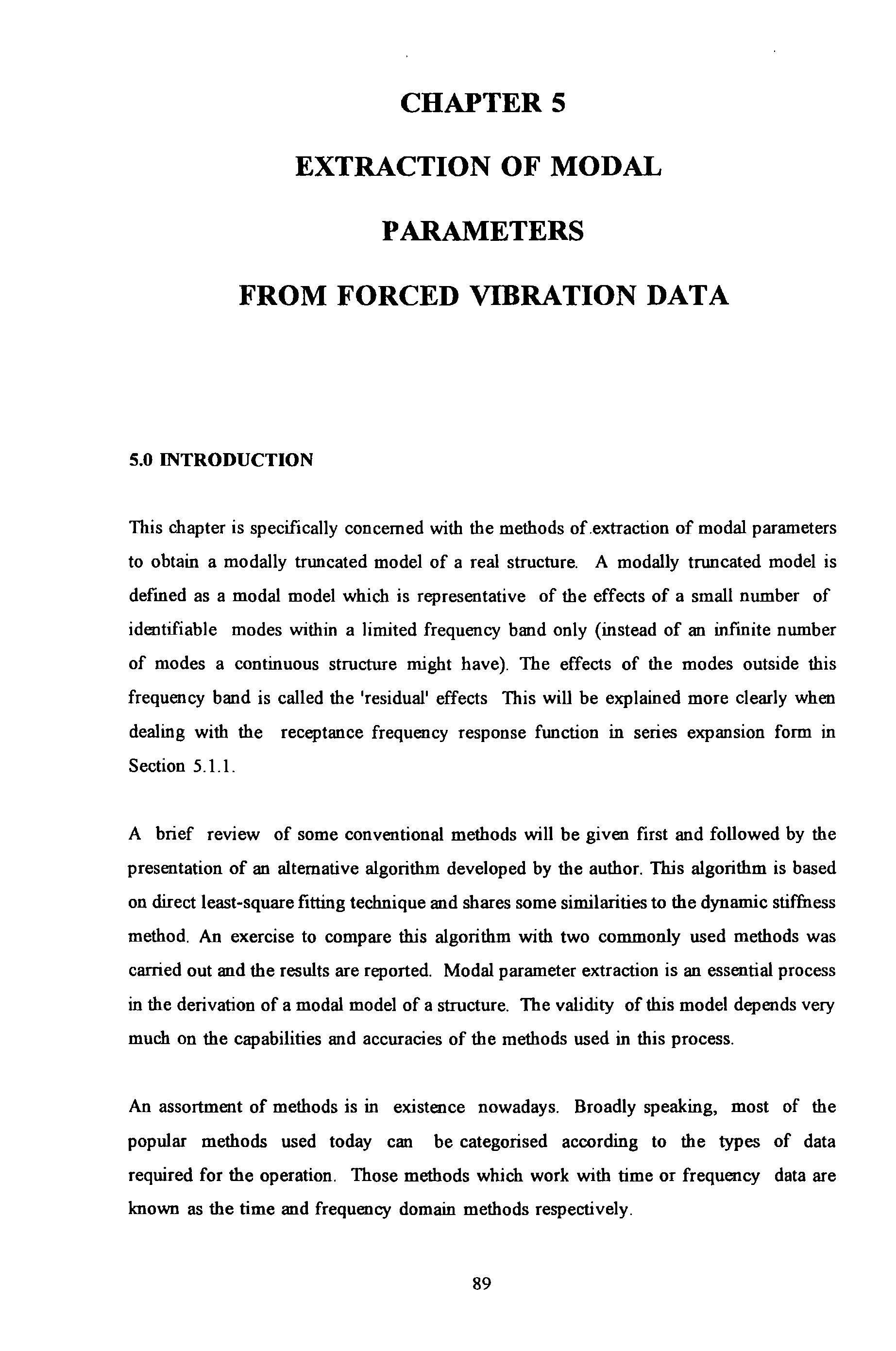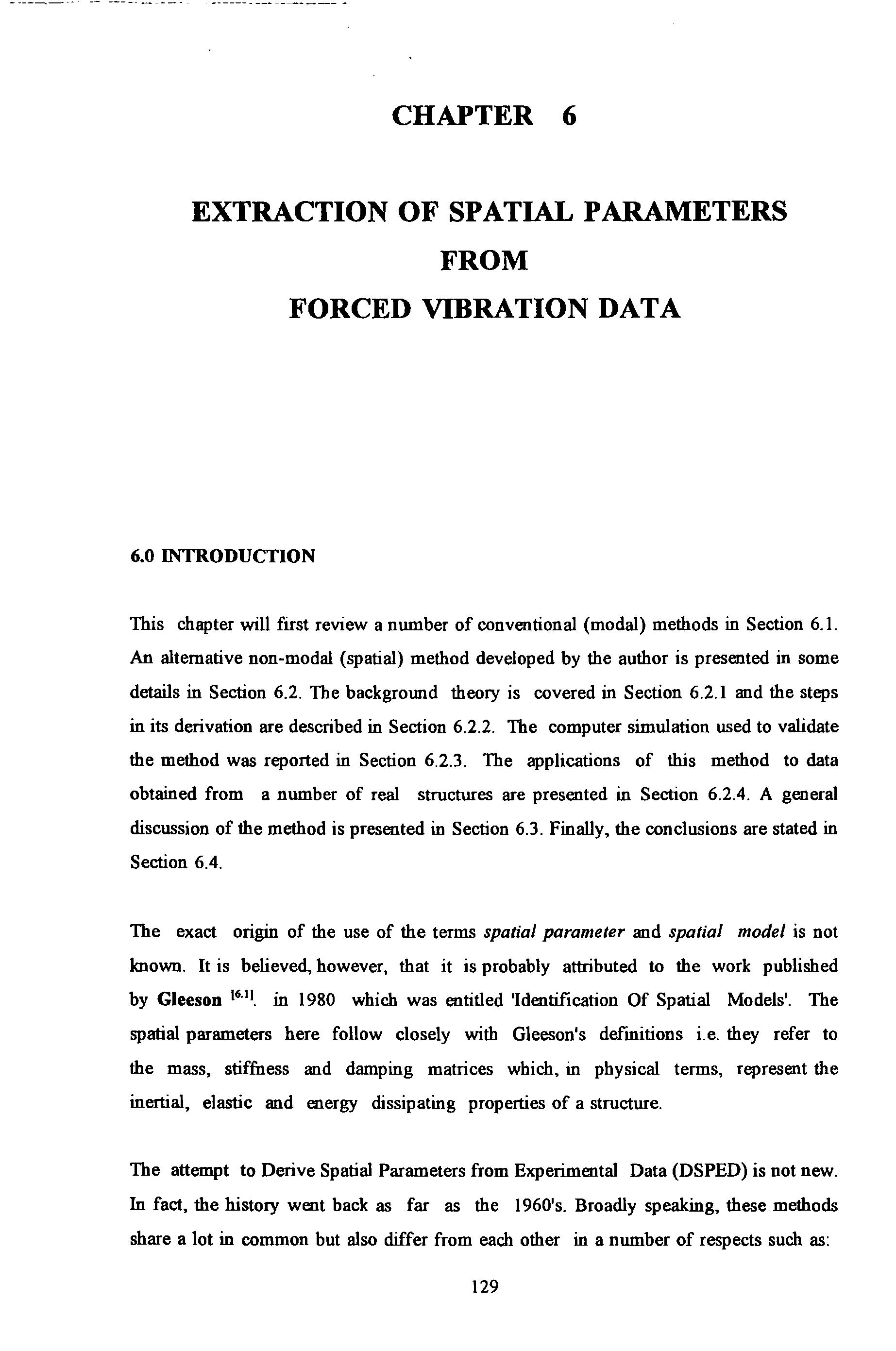
6 minute read
EXTRACTION OF SPATIAL PARAMETERS FROM FORCED VIBRATION DATA
from Technique of Determination of Structural Parameters From Forced Vibration Testing
by Straam Group
6.0 INTRODUCTION
This chapter will first review a number of conventional (modal) methods in Section 6.1. An alternative non-modal (spatial) method developed by the author is presented in some details in Section 6.2. The background theory is covered in Section 6.2.1 and the steps in its derivation are described in Section 6.2.2. The computer simulation used to validate the method was reported in Section 6.2.3. The applications of this method to data obtained from a number of real structures are presented in Section 6.2.4. A general discussion of the method is presented in Section 6.3. Finally, the conclusions are stated in Section 6.4.
Advertisement
The exact origin of the use of the terms spatial parameter and spatial model is not known. It is believed, however, that it is probably attributed to the work published by Gleeson 16 11 in 1980 which was entitled 'Identification Of Spatial Models'. The spatial parameters here follow closely with Gleeson's defmitions i.e. they refer to the mass, stiffness and damping matrices which, in physical terms, represent the inertial, elastic and energy dissipating properties of a structure.
The attempt to Derive Spatial Parameters from Experimental Data (DSPED) is not new.
In fact, the history went back as far as the 1960's. Broadly speaking, these methods share a lot in common but also differ from each other in a number of respects such as: a. whether pnor knowledge of or assumptions about some of the matrices are required, b. whether the approach is a direct one or is one based on iterative search or optimization methodology and c. whether the identification of modal parameters are required prior to the determination of the spatial matrices.
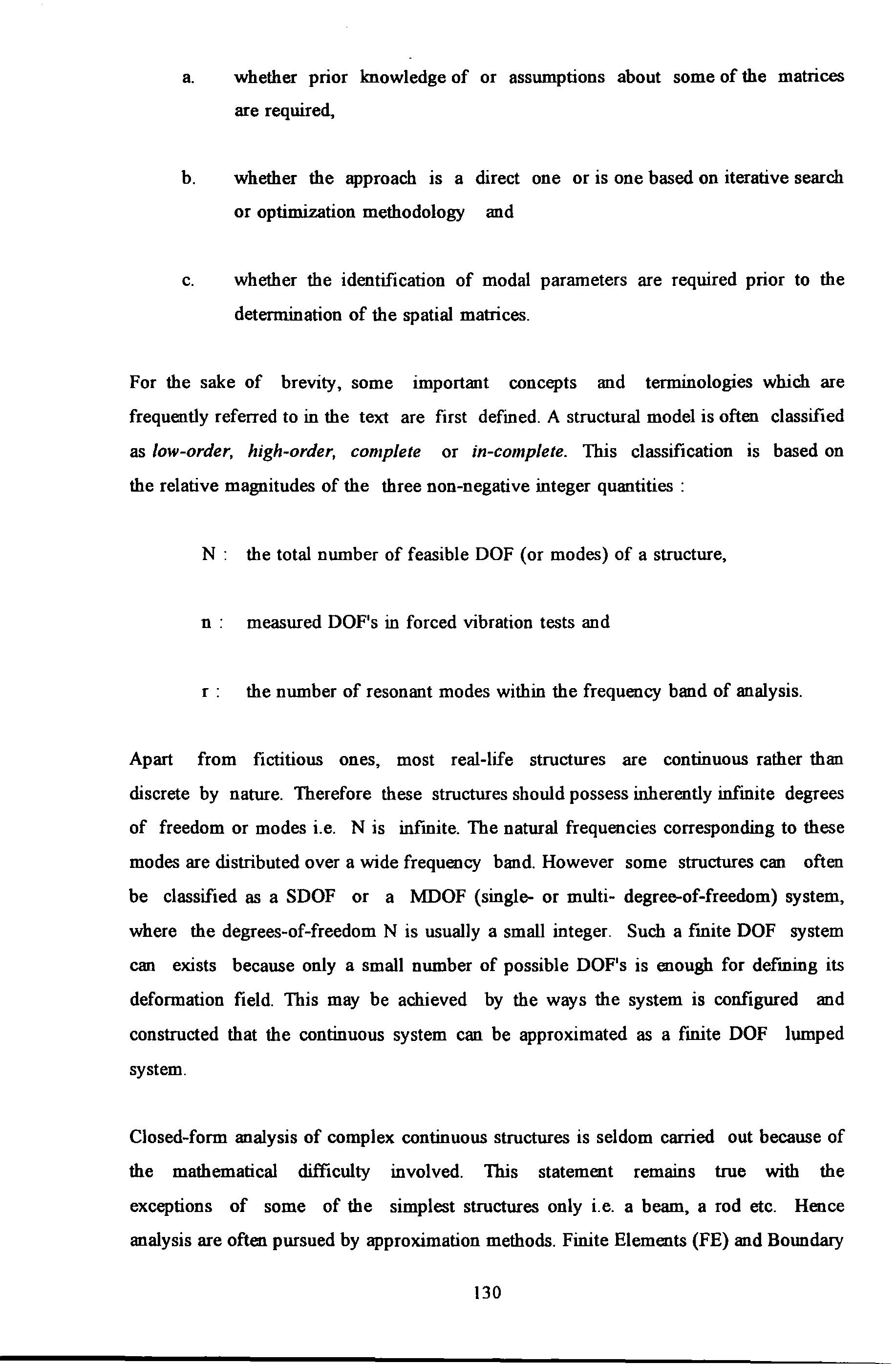
For the sake of brevity, some important concepts and terminologies which are frequently referred to in the text are first defined. A structural model is often classified as low-order, high-order, complete or in-complete. This classification IS based on the relative magnitudes of the three non-negative integer quantities :
N : the total number of feasible DOF (or modes) of a structure, n : measured DOF's in forced vibration tests and r : the number of resonant modes within the frequency band of analysis.
Apart from fictitious ones, most real-life structures are continuous rather than discrete by nature. Therefore these structures should possess inherently infmite degrees of freedom or modes i.e. N is infmite. The natural frequencies corresponding to these modes are distributed over a wide frequency band. However some structures can often be classified as a SDOF or a MDOF (single- or multi- degree-of-freedom) system, where the degrees-of-freedom N is usually a small integer. Such a fmite DOF system can exists because only a small number of possible DOF's is enough for defming its deformation field. This may be achieved by the ways the system is configured and constructed that the continuous system can be approximated as a fmite DOF lumped system.
Closed-form analysis of complex continuous structures is seldom carried out because of the mathematical difficulty involved. This statement remains true with the exceptions of some of the simplest structures only i.e. a beam, a rod etc. Hence analysis are often pursued by approximation methods. Finite Elements (FE) and Boundary
Elements (BE) methods are the two most popular methods used by analysts. An FE or BE model of a structure usually incorporates a finite number, but still a very large number, of nodes and elements. The deformation field of each element is specified by the DOFs at all its nodes. Hence the total number of DOFs of all the active nodes and elements N is frequently very large. For this reason, an FE or a BE model is often classified as a high-order model.
By contrast, only a relatively small number of DOF can be measured from experiment. Therefore n is usually much smaller than N. For this reason, a model synthesized directly from measured data is often classified as a low-order, condensed or spatially trnncated model.
Apart from spatial truncations, most practical models are also modally or spectrally truncated. This is because, in practice, only a small number of modes in a very narrow frequency band is determined experimentally. As a result, r is usually much smaller than n. The model so obtained is called an incomplete model. Otherwise, if r is equal to n then the model is called a complete model.
6.1 CONVENTIONAL MODAL METHODS
By defmition, most of these methods require the determination of the relevant modal parameters as a pre-requisite step before the spatial matrices are determined.
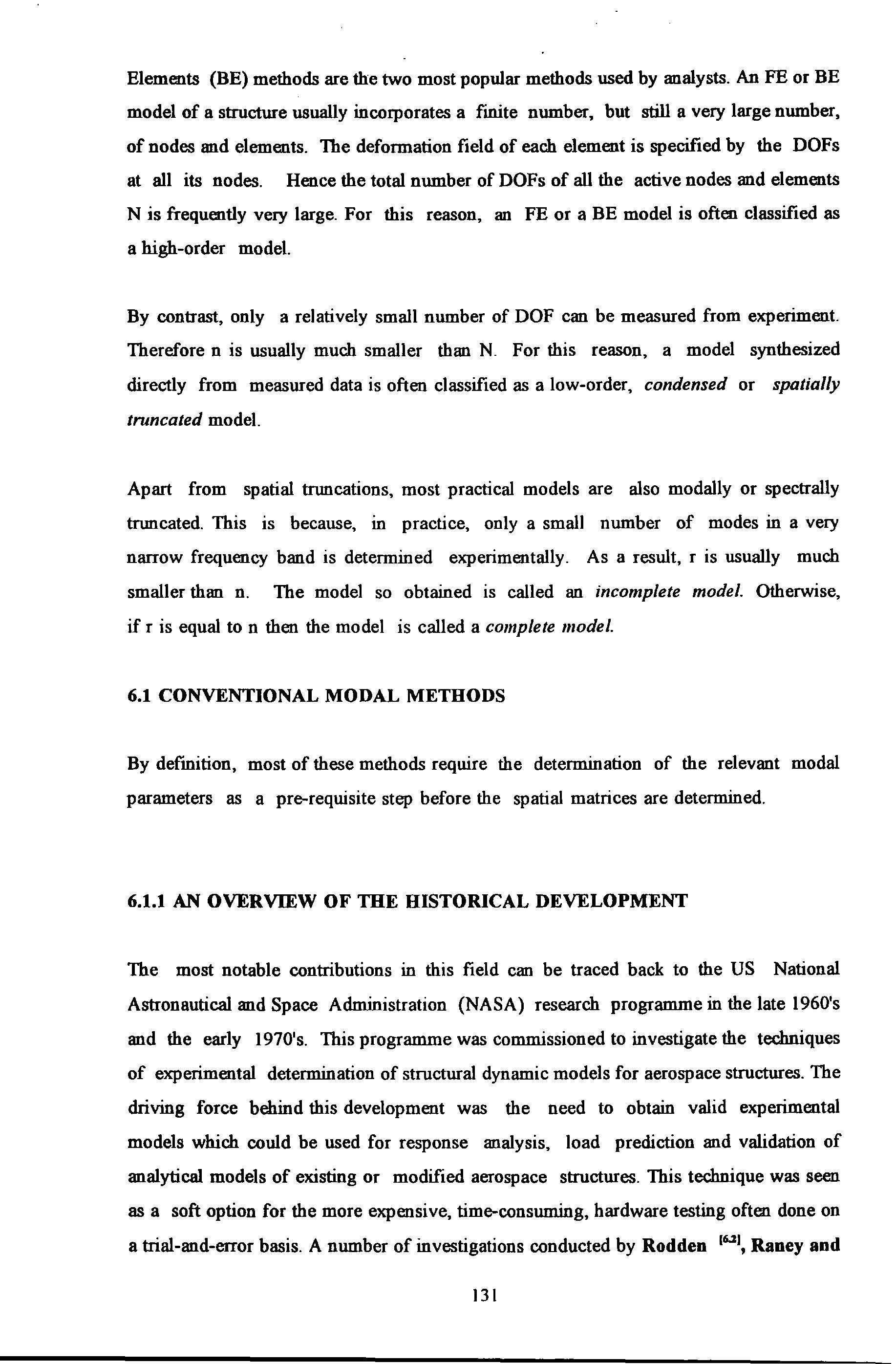
6.1.1 AN OVERVIEW OF THE HISTORICAL DEVELOPMENT
The most notable contributions in this field can be traced back to the US National Astronautical and Space Administration {NASA) research programme in the late 1960's and the early 1970's. This programme was commissioned to investigate the techniques of experimental determination of structural dynamic models for aerospace structures. The driving force behind this development was the need to obtain valid experimental models which could be used for response analysis, load prediction and validation of analytical models of existing or modified aerospace structures. This technique was seen as a soft option for the more expensive, time-consuming, hardware testing often done on a trial-and-error basis. A number of investigations conducted by Rodden l6.2l, Raney and
Hewlett 16.31, Ross 16.41, Thoren 16.51, Young and On 16.61, Kozin 16. 71 , Berman and Wei J6.SI were either a direct or an indirect result of this programme.
Historically, DSPED have undergone different phases of change and development. It was first perceived by Rodden 16.21 in 1967 as a process of determining the structural influencing coefficients using ground vibration tests. In 1968, Kozin I6.7J considered this as a parameter identification process. The identification procedure which he proposed was based upon statistical expectations and time averaging technique. The method was tested by a series of simulation studies and proven applicable to both linear and non-linear systems.
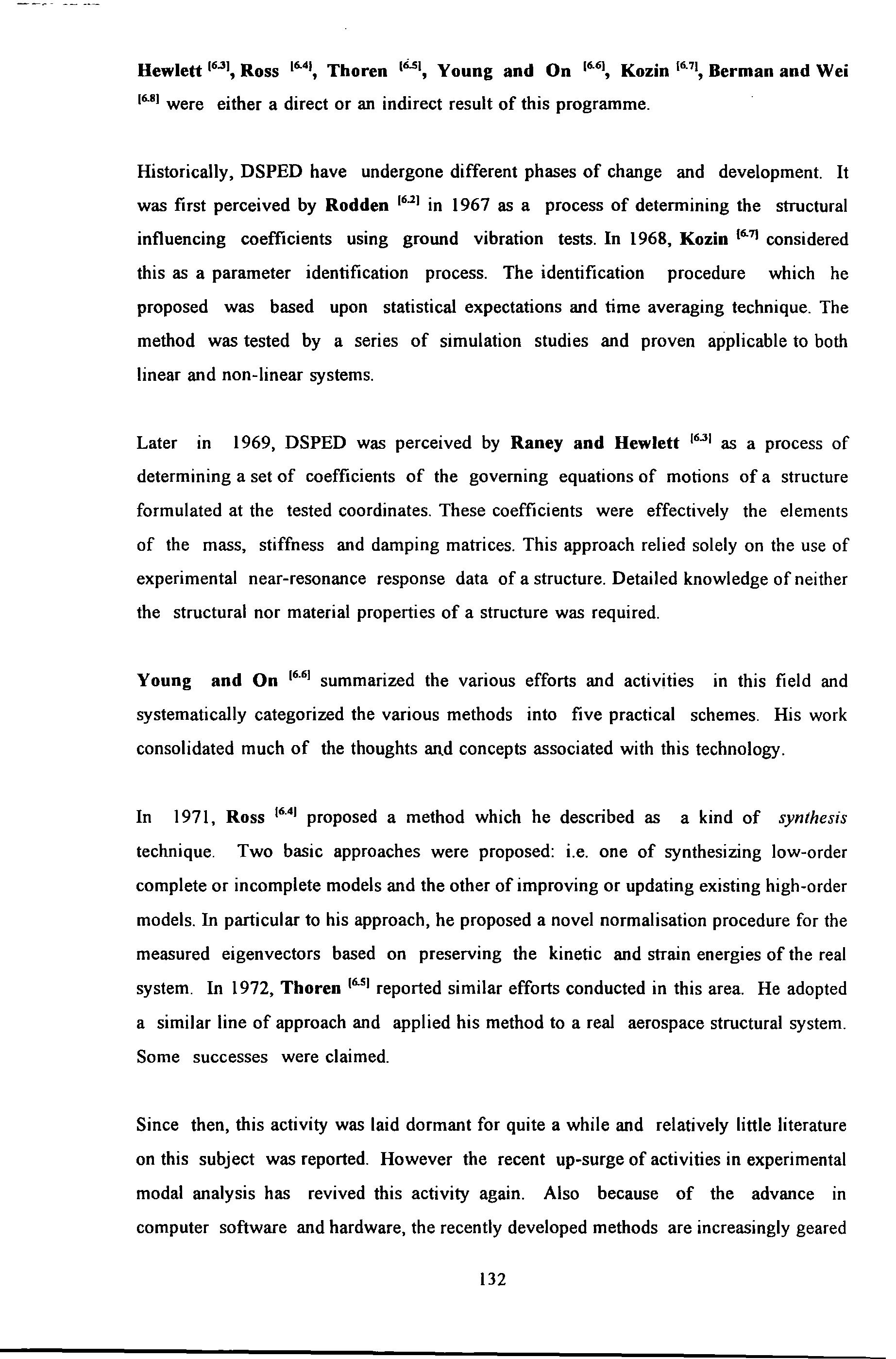
Later m 1969, DSPED was perceived by Raney and Hewlett 16.JI as a process of determining a set of coefficients of the governing equations of motions of a structure formulated at the tested coordinates. These coefficients were effectively the elements of the mass, stiffness and damping matrices. This approach relied solely on the use of experimental near-resonance response data of a structure. Detailed knowledge of neither the structural nor material properties of a structure was required.
Young and On 16 61 summarized the vanous efforts and activities m this field and systematically categorized the various methods into five practical schemes. His work consolidated much of the thoughts and concepts associated with this technology.
In 1971, Ross 16 41 proposed a method which he described as a kind of synthesis technique. Two basic approaches were proposed: i.e. one of synthesizing low-order complete or incomplete models and the other of improving or updating existing high-order models. In particular to his approach, he proposed a novel normalisation procedure for the measured eigenvectors based on preserving the kinetic and strain energies of the real system. In 1972, Thoren J6.SJ reported similar efforts conducted in this area. He adopted a similar line of approach and applied his method to a real aerospace structural system. Some successes were claimed.
Since then, this activity was laid dormant for quite a while and relatively little literature on this subject was reported. However the recent up-surge of activities in experimental modal analysis has revived this activity again. Also because of the advance in computer software and hardware, the recently developed methods are increasingly geared to large scale data processmg associated with high order models.
6.1.2 METHODS REQUIRING PRIORI ASSUMPTIONS
These methods are all typical m the way that priori assumptions on some of the parameters have to be made before other interested parameters can be determined. Nielsen rur is believed to be one of the first to have used this approach. He developed a number of procedures to calculate the elements in the stiffness and damping matrices from experimentally measured modal properties using classical normal mode theories.
In particular to his method, his procedures formulated the problem in such a way that the solution process was reduced to solving a system of simultaneous linear equations. The unknown vector in these equations contains the unknown elements of the stiffness and damping matrices. This method differs from the other methods based on optimization methodology in the way that the unknown parameters were determined directly rather than through iterative search schemes.
This procedure relied not only on a prior knowledge of the mass matrix but also on further restriction on the mass matrix for the procedures to work. In most cases, the mass matrix was assumed diagonal i.e. lumped mass rather than consistent mass model. With this method, the various requirements on the number of modes, hence the number of available equations, for a solution of a number of systems: known as simply-coupled, far-coupled and close-coupled systems, can be determined.
Sokal 16"91 proposed a similar approach which determined a stiffness matrix [K] directly from an assumed mass matrix [M] and an incomplete set of modal matrices. In particular to his approach, the algorithm proposed did not require the computation of the inverse of the modal matrix and was therefore applicable to incomplete models.
All these methods are based on the assumption that the mass of a structure can be estimated from design drawings with some degrees of certainty. However, m reality, the mass matrix [M] of a structure is not easy to determine accurately. These methods were applied to relatively simple systems only and spatial matrices of the low order category only were obtained.
